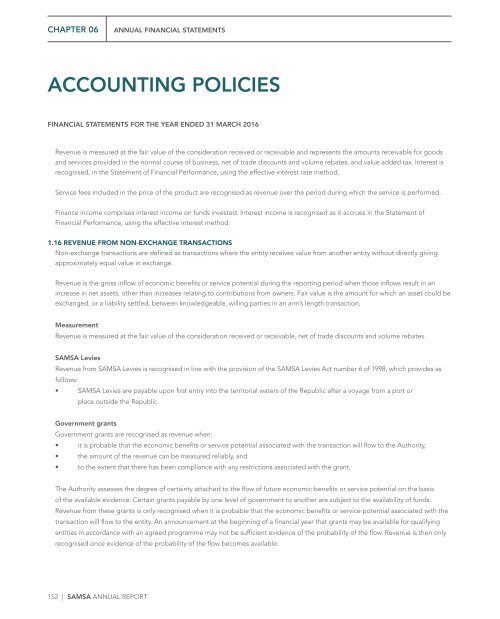SAMSA Annual Report 2015 - 2016
You also want an ePaper? Increase the reach of your titles
YUMPU automatically turns print PDFs into web optimized ePapers that Google loves.
CHAPTER 06 ANNUAL FINANCIAL STATEMENTS ANNUAL FINANCIAL STATEMENTS CHAPTER 06<br />
ACCOUNTING POLICIES<br />
ACCOUNTING POLICIES<br />
FINANCIAL STATEMENTS FOR THE YEAR ENDED 31 MARCH <strong>2016</strong> FINANCIAL STATEMENTS FOR THE YEAR ENDED 31 MARCH <strong>2016</strong><br />
Revenue is measured at the fair value of the consideration received or receivable and represents the amounts receivable for goods<br />
and services provided in the normal course of business, net of trade discounts and volume rebates, and value added tax. Interest is<br />
recognised, in the Statement of Financial Performance, using the effective interest rate method.<br />
Service fees included in the price of the product are recognised as revenue over the period during which the service is performed.<br />
Finance income comprises interest income on funds invested. Interest income is recognised as it accrues in the Statement of<br />
Financial Performance, using the effective interest method.<br />
1.16 REVENUE FROM NON-EXCHANGE TRANSACTIONS<br />
Non-exchange transactions are defined as transactions where the entity receives value from another entity without directly giving<br />
approximately equal value in exchange.<br />
Restrictions on government grants may result in such revenue being recognised on a time-proportion basis. Where there is no<br />
restriction on the period, such revenue is recognised on receipt or when the Act becomes effective, whichever is earlier.<br />
When government remit grants on a reimbursement basis, revenue is recognised when the qualifying expense has been incurred<br />
and to the extent that any other restrictions have been complied with.<br />
Other grants and donations<br />
Other grants and donations are recognised as revenue when:<br />
• it is probable that the economic benefits or service potential associated with the transaction will flow to the Authority;<br />
• the amount of the revenue can be measured reliably; and<br />
• to the extent that there has been compliance with any restrictions associated with the grant.<br />
Revenue is the gross inflow of economic benefits or service potential during the reporting period when those inflows result in an<br />
increase in net assets, other than increases relating to contributions from owners. Fair value is the amount for which an asset could be<br />
exchanged, or a liability settled, between knowledgeable, willing parties in an arm’s length transaction.<br />
Measurement<br />
Revenue is measured at the fair value of the consideration received or receivable, net of trade discounts and volume rebates.<br />
<strong>SAMSA</strong> Levies<br />
Revenue from <strong>SAMSA</strong> Levies is recognised in line with the provision of the <strong>SAMSA</strong> Levies Act number 6 of 1998, which provides as<br />
follows:<br />
• <strong>SAMSA</strong> Levies are payable upon first entry into the territorial waters of the Republic after a voyage from a port or<br />
place outside the Republic.<br />
Government grants<br />
Government grants are recognised as revenue when:<br />
• it is probable that the economic benefits or service potential associated with the transaction will flow to the Authority,<br />
• the amount of the revenue can be measured reliably, and<br />
• to the extent that there has been compliance with any restrictions associated with the grant.<br />
The Authority assesses the degree of certainty attached to the flow of future economic benefits or service potential on the basis<br />
of the available evidence. Certain grants payable by one level of government to another are subject to the availability of funds.<br />
Revenue from these grants is only recognised when it is probable that the economic benefits or service potential associated with the<br />
transaction will flow to the entity. An announcement at the beginning of a financial year that grants may be available for qualifying<br />
entities in accordance with an agreed programme may not be sufficient evidence of the probability of the flow. Revenue is then only<br />
recognised once evidence of the probability of the flow becomes available.<br />
If goods in-kind are received without conditions attached, revenue is recognised immediately. If conditions are attached, a liability is<br />
recognised, which is reduced and revenue recognised as the conditions are satisfied.<br />
1.17 BAD DEBTS<br />
It is the policy of the Authority to handle each potential bad debt case or impairment allowance on merit. A provision is made for all<br />
debtors which are likely not going to be paid over to <strong>SAMSA</strong>. Where there is objective evidence and indications to the impairment of<br />
a debt, such debts are written off.<br />
1.18 INVESTMENT INCOME<br />
Investment income is recognised on a time-proportion basis using the effective interest method.<br />
1.19 TRANSLATION OF FOREIGN CURRENCIES<br />
Foreign currency transactions<br />
A foreign currency transaction is recorded, on initial recognition in Rands, by applying to the foreign currency amount the spot<br />
exchange rate between the functional currency and the foreign currency at the date of the transaction.<br />
At each reporting date:<br />
• foreign currency monetary items are translated using the closing rate;<br />
• non-monetary items that are measured in terms of historical cost in a foreign currency are translated using the exchange rate<br />
at the date of the transaction; and<br />
• non-monetary items that are measured at fair value in a foreign currency are translated using the exchange rates at the date<br />
when the fair value was determined.<br />
Exchange differences arising on the settlement of monetary items or on translating monetary items at rates different from those at<br />
which they were translated on initial recognition during the period or in previous financial statements are recognised in surplus or<br />
deficit in the period in which they arise.<br />
152 | <strong>SAMSA</strong> ANNUAL REPORT <strong>SAMSA</strong> ANNUAL REPORT | 153


